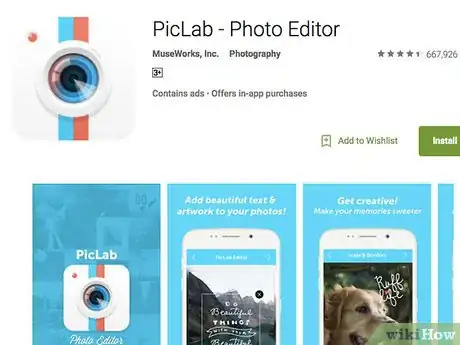This article was co-authored by Lynn Kirkham. Lynn Kirkham is a Professional Public Speaker and Founder of Yes You Can Speak, a San Francisco Bay Area-based public speaking educational business empowering thousands of professionals to take command of whatever stage they've been given - from job interviews, boardroom talks to TEDx and large conference platforms. Lynn was chosen as the official TEDx Berkeley speaker coach for the last four years and has worked with executives at Google, Facebook, Intuit, Genentech, Intel, VMware, and others.
There are 10 references cited in this article, which can be found at the bottom of the page.
This article has been viewed 192,987 times.
Making a good quote can help you communicate your message to key audiences. If you are hoping to make your upcoming speech or social media post more memorable, you may want to learn the art of writing good quotes. It is important to carefully consider your audience and key message before drafting quotes. Once you have a few drafts in your notebook, you can start revising the quotes for boldness, concision and resonance. You can also combine your quote with a compelling image to make a popular social media post.[1]
Steps
Writing Good Quotes
-
1Figure out your themes. Brainstorm a list of the top themes you want to address with your quote. Give yourself fifteen minutes to jot down the themes or issues you want to address with your quote. You can use point form, such as single words or short phrases that indicate a theme.[2]
- If you are writing a sports quote, your key themes might include: performance, athleticism, endurance, perseverance and nutrition.
- If you are writing a business quote, your key themes could include: competition, new markets, collaboration, opportunity and strategic planning.
- If you are creating a quote about charity or politics, you might be focusing on a particular issue such as homelessness, poverty, environmental degradation or health care.
-
2Write your key message. Consider what you want your audience to understand about the theme or issue you have identified. If there is a key message you want your audience to walk away with after reading your quote, you should write it down. At this point, you can write your communications goal as a short paragraph.[3]
- For instance, you could write: “I want my teammates to understand the importance of diet and nutrition for athletic performance. Specifically, I want them to understand the importance of eating enough protein.”
- If you are writing about homelessness in your city, you could write: “I want my audience to understand the scope of the homelessness problem in our city. I also want them to understand that homelessness is connected to poverty and income.”
Advertisement -
3Make your quotes pithy. You want your quotes to be pithy, which means packing a lot of meaning into a short phrase. Your quote should be like a headline that grabs attention, rather than a long story at the back of the business section.[4] The following examples illustrate how one can pack a lot of meaning into a short quote:
- Anne Frank’s Diary of a Young Girl includes the line: “How wonderful it is that nobody need wait a single moment before starting to improve the world.”[5]
- John F. Kennedy said, “As we express our gratitude, we must never forget that the highest appreciation is not to utter words, but to live by them.”[6]
-
4Use imagery to communicate meaning. A vivid image can help you pack a lot of meaning into a short phrase. Good quotes are often evocative and memorable because of a particular image that the quote calls to mind. So, you could start by brainstorming various images or pictures to anchor your quote.[7]
- John Berger wrote: “In Degas’s compositions with several dancers, their steps, postures and gestures often resemble the almost geometric, formal letters of an alphabet, whereas their bodies and heads are recalcitrant, sinuous and individual.”[8]
-
5Use metaphor. If you attach a name or image to one thing that belongs to something else and do not use “like” or “as” to make the comparison, you are making a metaphor.[9]
- For instance, you could write: “His eyes were moonlight.”[10]
- Metaphors allow your writing to be more economical and concise. If your metaphor is apt, people will remember it as a great quote.
-
6Integrate data into the quote. People may be more likely to remember your quote if it references important or surprising data. However, instead of integrating actual numbers and decimal points, you should use approximations and ratios. For instance, you could use phrases like, “twice as many” or “one third of Americans.”[11]
- The CEO of the Institute for Sustainable Investing observed: “Really significantly, [millenials are] twice as likely to invest in a stock or a fund if sustainability is part of the value-creation thesis.”[12]
-
7Revise a famous quote to suit your topic. Take a famous quote and tweak it to your own specifications and beliefs. For instance, you could find a famous quote by searching on Google. Then, use your sense of humor to revise the quote so that it speaks to the topic you are discussing.
- For instance, you could revise John F. Kennedy's 'Think not what your country can do for you, but what you can do for your country!'. Insert a different topic in place of country, such as ‘safety’. So, the revised quote would read: 'Think not what safety can do for you, but what you can do for safety!'
-
8Address a life virtue. For instance, consider making a quote about patience, kindness, good judgment or decisiveness. Then, use a simile or analogy to show a correspondence between two things that are relevant to this virtue. For instance, the act of making a decision in the game of chess is analogous to making a decision in life itself. This analogy can be the basis for a quote:[13]
- 'Life is like a game of chess. There are many moves to take, but you ultimately have to take one nonetheless.'
- Oscar Wilde used simile to create memorable lines about love: “Keep love in your heart. A life without it is like a sunless garden when the flowers are dead.”[14]
-
9Make it personal. Find something that relates to your life and experience. Rather than using images or metaphors that have no correspondence with your own life experience, you should try to integrate a personal perspective into the quote.
- For example, if you are in high school, you could write: 'Life is a road, and high school is just a pothole.'
- Don't just grab a quote from a book of quotes or a quotations website. Come up with your own quote.
-
10Write 10 drafts of the quote. Using imagery, metaphor, simile, data references and other techniques, compose ten distinct drafts of your quote. Once you have 10 drafts, you can review them to find the most memorable version.[15]
- Write them by hand on a sheet of paper or on the computer. Number them 1 through 10.
Revising and Testing Quotes
-
1Make it bold. Consider how you could make your quote bold and definitive. A memorable quote draws clear distinctions and offers clear judgments about an issue, rather than making vague remarks.[16] For instance, the following quotes are good examples of boldness:
- John F. Kennedy said, “My fellow Americans, ask not what your country can do for you, ask what you can do for your country.”[17]
- Robin Sharma said, “Leadership is not about a title or a designation. It’s about impact, influence and inspiration. Impact involves getting results, influence is about spreading the passion you have for your work, and you have to inspire teammates and customers.”
-
2Cut extraneous references. Your quote should not require a long explanation for people to get it. You should be able to say your quote and get an immediate response from an audience. If you find any references that your audience might not understand, you should cut them.[18]
- For instance, if your quote includes acronyms or technical jargon, you might want to cut it.
- If your quote contains references to specific programs that your audience might not be familiar with, you should consider cutting those references.
-
3Aim for resonance. Your quote should resonate with people’s ideas or feelings about the issue or theme you are addressing. When you say your quote, you want people to remark that they have the same idea or that they were thinking the same thing but didn’t know how to put it into words. This is sometimes called the “amen” factor.[19]
- Consider your audience. What resonates with one group won't resonate with another.
-
4Do a soft launch. If you want to use your quote at a big talk, speech or include it in a publication, you should test it with a few people first. Say it to friends or colleagues to see whether it resonates with them. At this stage, you should try to get some constructive feedback. Ask your friends and colleagues what they like and dislike about the quote.[20]
- After your soft launch, be sure to work on revising it until you find something memorable.
-
5Share your quote. Share your quote with friends, colleagues or online. If it resonates with folks, you can use it as part of your personal branding. It is good to have a few quotes, however, so you avoid overusing a particular phrase.[21]
- Have different quotes for different groups and situations. For example, the quote that you use in the workplace would be different then the quote you use at a party.
Creating Quotes for Social Media
-
1Use a text art tool. There are a wide range of online text art tools that allow you to combine your quote with an image. These tools will allow you to choose from a selection of fonts, templates, colors and background images, so you don’t need to be a graphic designer to make an inspirational or sarcastic quote on social media.
- There are various text art tools that you can use, which include both free and paid platforms for making social media quotes.[22]
-
2Find an image for your quote. You can choose between an image from a template or your own image. If you want to get really creative, you could take a photograph of something that inspired your quote, upload it and then insert your quote over the image.
- If you are short on time, just pick one of the image templates.
-
3Cut and paste your quote into the program. If you wrote the quote in a text edit program, you will need to cut and paste it into the text box in the text art software. Some of the programs will give you one text box to include both the quote and the author, whereas others will give you a text box for the quote and another box for the author attribution.
- Don't worry if the text fits into the text box just yet. You will fix that when you format it.
-
4Format the quote. Once you have your image and your quote in the text art program, you can play around with the formatting. For instance, you could try:
- Putting the quote in italics or bold
- Changing the font face, such as Times New Roman, Arial, etc.
- Switching the colors of the text so that it stands out against the background.
- Making the background slightly transparent to make the message stand out even more.
-
5Use a mobile application. If you want to create your social media quotes with your mobile phone or tablet, there are a variety of text art tools that can help. Mobile applications allow you to create a quote, choose a font and background image and then share it on social media. You can also save the images to your phone or email them to yourself.
- Whims is a popular mobile quote application. It is a free application for iOS devices.
- PicLab works on iOS, Android and Windows phones.
-
6Share your quote on social media. Once you have added photos or background images to your quote, you can share it on social media platforms such as Instagram of Facebook. The combination of text and image makes for a more popular social media post than text alone.
Expert Q&A
-
QuestionWhat is the best quote?
 Lynn KirkhamLynn Kirkham is a Professional Public Speaker and Founder of Yes You Can Speak, a San Francisco Bay Area-based public speaking educational business empowering thousands of professionals to take command of whatever stage they've been given - from job interviews, boardroom talks to TEDx and large conference platforms. Lynn was chosen as the official TEDx Berkeley speaker coach for the last four years and has worked with executives at Google, Facebook, Intuit, Genentech, Intel, VMware, and others.
Lynn KirkhamLynn Kirkham is a Professional Public Speaker and Founder of Yes You Can Speak, a San Francisco Bay Area-based public speaking educational business empowering thousands of professionals to take command of whatever stage they've been given - from job interviews, boardroom talks to TEDx and large conference platforms. Lynn was chosen as the official TEDx Berkeley speaker coach for the last four years and has worked with executives at Google, Facebook, Intuit, Genentech, Intel, VMware, and others.
Public Speaking Coach The most powerful quotes come from the heart. Your quote needs to feel authentic and speak to you and your audience. It should inspire people or make a point. Make your quote personal and genuine.
The most powerful quotes come from the heart. Your quote needs to feel authentic and speak to you and your audience. It should inspire people or make a point. Make your quote personal and genuine. -
QuestionDoes this quote sound good? "No one deserves to be alone."
 Community AnswerIt sounds plain, but with the right imagery it could make a bold statement.
Community AnswerIt sounds plain, but with the right imagery it could make a bold statement. -
QuestionWhere can I post my new quotes that I come up with all by myself?
 Community AnswerI post mine on tumblr, but you can post them on Pinterest, Instagram, or basically any social media.
Community AnswerI post mine on tumblr, but you can post them on Pinterest, Instagram, or basically any social media.
Warnings
- Be aware of plagiarism and copyright laws. Some quotes you believe are yours may be already taken.⧼thumbs_response⧽
References
- ↑ http://joshshipp.com/write-memorable-quotes/
- ↑ http://joshshipp.com/write-memorable-quotes/
- ↑ http://joshshipp.com/write-memorable-quotes/
- ↑ https://www.fastcompany.com/3065299/4-tips-for-dropping-quotable-one-liners-into-your-next-big-talk
- ↑ https://www.theguardian.com/childrens-books-site/2015/jan/27/the-greatest-anne-frank-quotes-ever
- ↑ https://www.brainyquote.com/slideshow/authors/top_10_john_f_kennedy_quotes.html
- ↑ https://www.fastcompany.com/3065299/4-tips-for-dropping-quotable-one-liners-into-your-next-big-talk
- ↑ https://www.brainyquote.com/search_results.html?q=john+berger
- ↑ https://owl.english.purdue.edu/owl/resource/687/05/
- ↑ http://www.powerpoetry.org/actions/7-tips-creating-poignant-poetic-metaphors
- ↑ https://www.fastcompany.com/3065299/4-tips-for-dropping-quotable-one-liners-into-your-next-big-talk
- ↑ https://www.fastcompany.com/3065299/4-tips-for-dropping-quotable-one-liners-into-your-next-big-talk
- ↑ https://www.butte.edu/departments/cas/tipsheets/style_purpose_strategy/analogy.html
- ↑ https://www.brainyquote.com/quotes/authors/o/oscar_wilde.html
- ↑ http://joshshipp.com/write-memorable-quotes/
- ↑ http://joshshipp.com/write-memorable-quotes/
- ↑ https://www.brainyquote.com/slideshow/authors/top_10_john_f_kennedy_quotes.html
- ↑ http://joshshipp.com/write-memorable-quotes/
- ↑ http://joshshipp.com/write-memorable-quotes/
- ↑ http://joshshipp.com/write-memorable-quotes/
- ↑ https://www.fastcompany.com/3065299/4-tips-for-dropping-quotable-one-liners-into-your-next-big-talk
- ↑ http://lightspandigital.com/blog/how-to-make-quote-images-9-great-tools/#axzz4cRpxfNm9
About This Article
Coming up with a good quote may seem like a challenge, but there are several things you can do to make what you say stick in people’s minds. Focus on the key message you want to get across, such as athleticism, competitiveness, or homelessness. You’ll want to communicate your opinion on this message in as few words as possible so it's easy to follow. Think about the interests or opinions of your audience as you prepare your quote, since you want it to resonate with them. Use imagery, like metaphor, to make your quote more memorable. If you're posting your quote on social media, you may want to combine it with a relevant image to make it more eye-catching. For tips from our Public Speaking co-author on how to upload your quote to social media, keep reading!





















































































